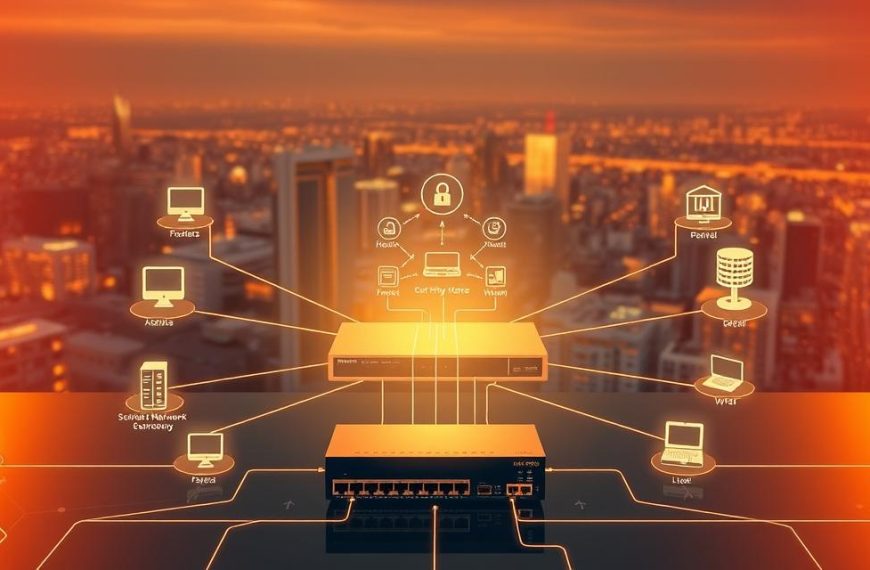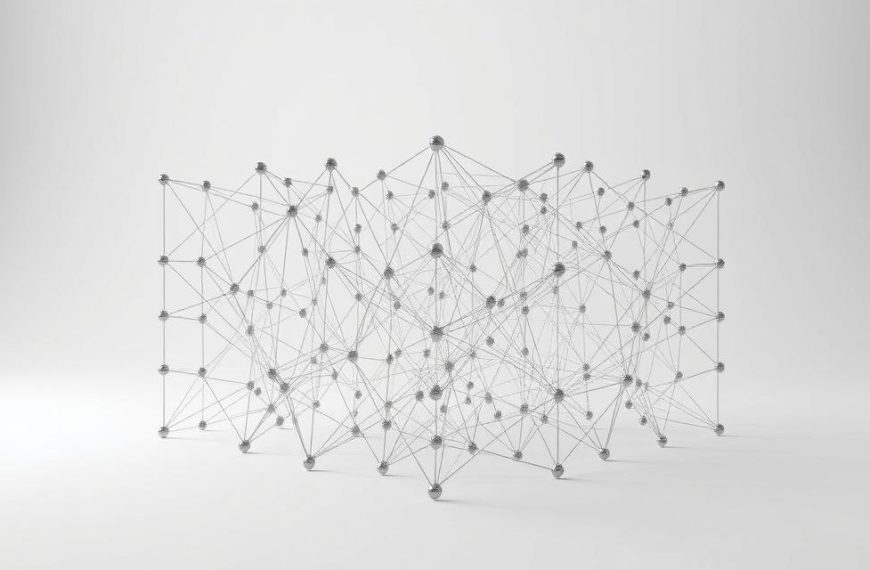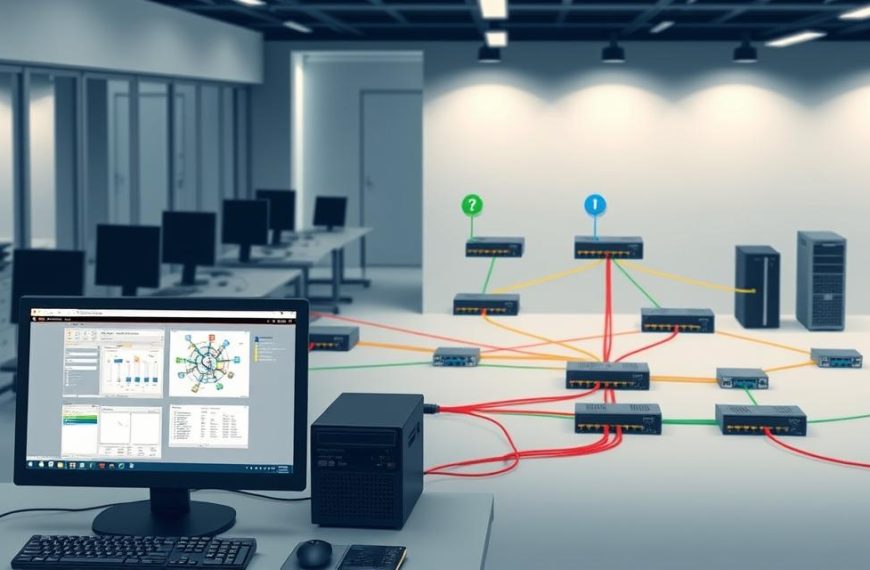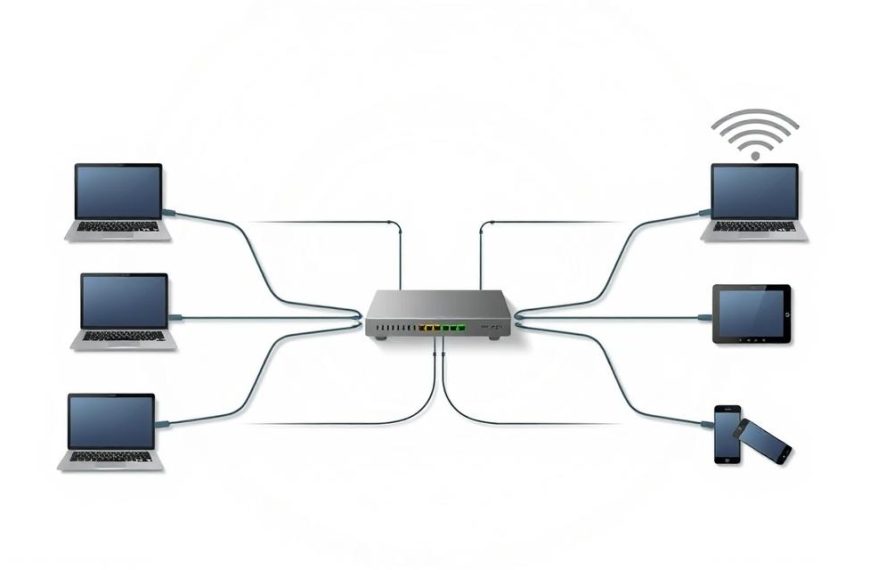In the digital world, a computer network definition is about systems that connect. They share resources and information using special rules.
These systems link devices like computers, servers, and peripherals. They make it easy to send data over short or long distances.
Today, we rely on these systems for many things. They are key to how we communicate and share resources online.
Knowing how these systems work is very important. The next parts will dive deeper into these topics.
Defining a Computer Network
Networking computers changed how we share and process information. It lets us communicate and work together across different devices and platforms.
Core Concept and Purpose
A computer network is a system of connected devices that talk to each other. They share resources and work together. This makes communication, sharing, and processing easier.
Today, networks are key to our digital lives. They help us share data and access resources smoothly. The right network components make these systems strong and efficient.
Historical Context and Evolution
Computer networking started with early experiments. In 1940, George Stibitz linked Dartmouth College with Bell Laboratories. This showed the power of remote computing.
The big leap came in 1969 with ARPANET. Funded by the US Department of Defense, it used packet switching. This laid the groundwork for today’s internet.
Networking has grown from simple data transport to complex digital systems. This journey has shaped how we connect globally today.
Key Components of a Network
To understand networks, you need to know their main parts. These elements work together to make sure devices can talk to each other easily.
Devices and Nodes
Every network has devices that send, receive, or pass on data. These are split into end devices and intermediary devices.
End Devices: Computers, Servers, and Peripherals
End devices are where communication starts or ends. Examples are computers, servers, printers, and smartphones. They connect using network interfaces like NICs (Network Interface Cards).
Servers offer resources, while clients use them. Peripherals like printers share services across the network.
Intermediary Devices: Routers, Switches, and Access Points
Intermediary devices help traffic flow well. Routers connect different networks, using IP addresses to decide where to send data.
Switches manage data in one network, using MAC addresses. Access points enable wireless connections, acting as bridges for Wi-Fi devices.
Other hardware includes hubs, repeaters, and bridges. Each helps extend or strengthen signals.
Transmission Media and Connectors
Transmission media carry data between devices. They can be wired or wireless, each with its own benefits.
Wired connections use physical cables for stability. Ethernet cables (e.g., Cat6) offer high speed over short distances.
Fibre optics use light signals for faster data transfer over long ranges. They are less prone to interference.
Wireless Media: Wi-Fi and Bluetooth
Wireless technologies offer mobility and convenience. Wi-Fi covers larger areas, perfect for homes and offices.
Bluetooth is for short-range device pairing, like headphones to phones. Both use radio waves for transmission.
| Media Type | Speed | Range | Use Case |
|---|---|---|---|
| Ethernet Cable | Up to 10 Gbps | 100 metres | Fixed setups |
| Fibre Optics | Up to 100 Gbps | Kilometres | Long-distance |
| Wi-Fi | Up to 9.6 Gbps | 100 metres | Flexible access |
| Bluetooth | Up to 3 Mbps | 10 metres | Personal devices |
Network Software and Protocols
Software and protocols control how devices talk to each other. Protocols like TCP/IP standardise data exchange.
Network operating systems manage resources and security. Together, they ensure reliable and efficient operations across diverse network types.
Types of Computer Networks
Networks are classified mainly by their size and structure. This helps IT experts design systems that meet specific needs. They balance performance, security, and cost well.
Based on Geography: LAN, WAN, and MAN
Geography is key in categorising networks. The size of a network affects its design and technology needs.
Local Area Networks (LANs) link devices in small areas like offices or schools. They use Ethernet or Wi-Fi for fast data transmission. Most home and small business networks are LANs.
Wide Area Networks (WANs) span large areas, connecting cities or countries. Internet providers use WANs with leased lines and fibre optic cables. They focus on reliability over speed.
Metropolitan Area Networks (MANs) cover areas like cities or campuses. They offer faster speeds than WANs but are wider than LANs. Many university and city networks use MANs.
Based on Architecture: Client-Server and Peer-to-Peer
Network architecture shows how devices interact. It affects how resources are managed and distributed.
Client-server networks have centralised servers and clients. This structure is secure and easy to manage. It’s common in corporate settings and web services.
Most companies use client-server networks. It helps in following policies and managing resources efficiently.
Peer-to-peer networks treat all devices equally. Each device can share resources without a central server. This is cheaper but harder to manage and secure.
Home networks and file-sharing apps often use peer-to-peer. It’s good for places where central management is hard.
| Network Type | Typical Coverage | Primary Use Cases | Speed Characteristics |
|---|---|---|---|
| LAN (Local Area Network) | Building or campus | Office networks, home networks | High speed (100 Mbps – 10 Gbps) |
| WAN (Wide Area Network) | Cities, countries, global | Internet backbone, multinational corporations | Variable speed (1 Mbps – 1 Gbps) |
| MAN (Metropolitan Area Network) | City or large region | University campuses, city services | Medium to high speed (10 Mbps – 10 Gbps) |
| Client-Server | Any geographical scope | Corporate environments, web applications | Depends on server capacity |
| Peer-to-Peer | Typically local scope | Home networks, file sharing applications | Limited by weakest device |
Today, networks often mix different architectures. Many use client-server for important services but peer-to-peer for sharing. This mix offers both security and flexibility.
New network types like cloud networks and software-defined WANs are changing the game. They keep the core principles but add new ways to manage and use networks.
How Networks Facilitate Device Communication
Modern networks use complex systems for easy device communication. They follow set standards and protocols for data travel across different networks.
Data Transmission Processes
Data transmission turns information into digital signals for network travel. It follows specific rules and standards, known as network protocols.
Packet Switching and Routing
Packet switching divides data into smaller packets for efficient sending. Each packet has address info and part of the data.
Network routers check packet headers to find the best path. This ensures data gets to its destination quickly.
Packets might take different paths and arrive in any order. The receiver puts them back together using sequence info in each packet.
IP addresses are unique for each device on a network. They help route data packets accurately.
The Domain Name System (DNS) turns domain names into IP addresses. It’s like a digital phonebook for the internet.
When you type a website address, your device asks DNS servers for the IP address. This happens automatically.
DNS has root servers, top-level domain servers, and authoritative name servers. This system ensures reliable domain resolution worldwide.
Common Network Services and Applications
Many services use network infrastructure for essential functions. They rely on specific network protocols for their work.
Email services use SMTP for sending and POP3 or IMAP for getting messages. These protocols help messages reach different email systems reliably.
Web browsing uses HTTP and HTTPS for client-server communication. These standards manage how browsers get and send web pages.
File sharing apps use FTP or newer protocols like BitTorrent. These systems make transferring large files across networks efficient.
Real-time communication tools, like video conferencing and VoIP, use special protocols. These protocols focus on quick delivery over perfect accuracy.
Cloud storage services sync data across devices using efficient protocols. This allows easy access to files from anywhere.
Each service uses the right network protocols for best performance. These standards ensure compatibility across different platforms and devices.
Conclusion
Computer networks are key to our digital world, making it easy for devices to talk to each other from anywhere. They help everyone, from big companies to individual users, in their daily digital activities.
From George Stibitz’s first network in 1940 to today’s advanced systems, we’ve made huge strides. Now, we have fast and reliable ways to share data and resources. This is thanks to technologies like Ethernet and wireless standards.
New trends like cloud networking, software-defined networks, and AI management are on the horizon. They will change how devices talk to each other in networks.
As computer networks keep getting better, they become even more important. They are vital for our personal, business, and social lives. They help us stay connected in a world where talking to devices is key.
















